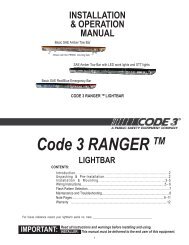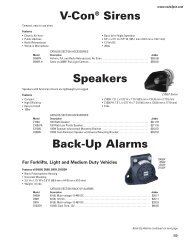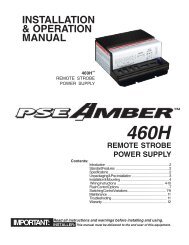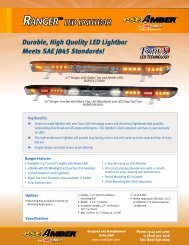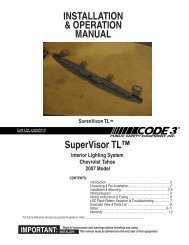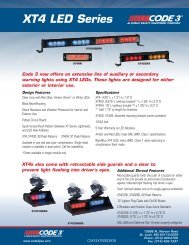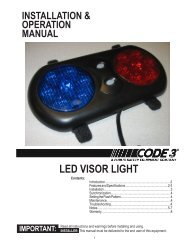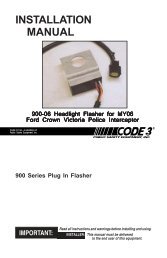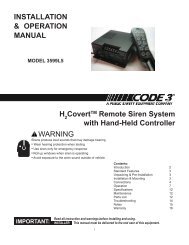MODEL 3000 & 3050 SIRENS - Code 3 Public Safety Equipment
MODEL 3000 & 3050 SIRENS - Code 3 Public Safety Equipment
MODEL 3000 & 3050 SIRENS - Code 3 Public Safety Equipment
- No tags were found...
Create successful ePaper yourself
Turn your PDF publications into a flip-book with our unique Google optimized e-Paper software.
WARNING!CONTINUED!!WARNING!Fuses or circuit breakers should be located as close to the power takeoff points as possibleand properly sized to protect the wiring and devices.Particular attention should be paid to the location and method of making electricalconnections and splices to protect these points from corrosion and loss of conductivity.Ground terminations should only be made to substantial chassis components, preferablydirectly to the vehicle battery.The user should install a fuse sized to approximately 125% of the maximum Amp capacityin the supply line to protect against short circuits. For example, a 30 Amp fuse shouldcarry a maximum of 24 Amps. DO NOT USE 1/4" DIAMETER GLASS FUSES AS THEYARE NOT SUITABLE FOR CONTINUOUS DUTY IN SIZES ABOVE 15 AMPS. Circuitbreakers are very sensitive to high temperatures and will "false trip" when mounted in hotenvironments or operated close to their capacity.Speaker ConnectionsDetermine the power rating of your speaker(s) at this point.Speaker Phasing - Whenever two speakers are used from one amplifier (two 58 watt, two 100 watt,or two 100 watt in the PSE200 configuration), they must be phased for maximum performance.Phasing involves connecting both speaker terminals marked #1 on the speaker together andconnecting both speaker terminals marked #2 on the speaker together. Be sure to check thespeaker terminals for the numbers, as the wire colors or speaker installation may be arbitrary.CONNECTION OF A 58 WATT SPEAKER TO THE 100 WATT TERMINAL WILL CAUSETHE SPEAKER TO BURN OUT, AND WILL VOID THE SPEAKER WARRANTY!The sound projection opening should be pointed forward, parallel to the ground, and notobstructed or muffled by structural components of the vehicle. Concealed or under-hoodmounting in some cases will result in a dramatic reduction in performance. To minimize thisreduction, mount the speaker so the sound emitted is projected directly forward andobstruction by vehicle components such as hoses, brackets, grille, etc. is minimized.Electromechanical sirens and electronic siren speakers should be mounted as far from theoccupants as possible using acoustically insulated compartments and isolation mounting tominimize the transmission of sound into the vehicle. It may be helpful to mount the device onthe front bumper, engine cowl or fender; heavily insulate the passenger compartment; andoperate the siren only with the windows closed.Each of these approaches may cause significant operational problems, including loss of sirenperformance from road slush, increased likelihood of damage to the siren in minor collisions,and the inability to hear the sirens on other emergency vehicles. APPROPRIATE TRAININGOF VEHICLE OPERATORS IS RECOMMENDED TO ALERT THEM TO THESEPROBLEMS AND MINIMIZE THE EFFECT OF THESE PROBLEMS DURINGOPERATIONS.Terminal Block Connections(-) - Negative (ground/earth) source of supply.(+) - Application of +12 VDC to this terminal will cause the siren to activate and produce the "Wail"tone.A - (<strong>3050</strong> Only) Application of +12 VDC to this terminal will produce "Air Horn" tone. Power neednot be supplied to (+) to terminal B.B - Application of +12 VDC to this terminal while the siren is energized [+12 VDC on terminal (+)]will produce the Yelp tone.Common - Speaker common terminal.58 - 58 watt speaker(s) terminal.100 - 100 watt speaker(s) terminal. Note: Connection of a 58 watt speaker to this terminal and thecommon terminal may destroy the speaker.SET-UP AND ADJUSTMENT!WARNING!Any electronic device may create or be affected by electromagnetic interference. Afterinstallation of any electronic device, operate all equipment simultaneously to insure thatoperation is free of interference. The speaker to Common and 58 (58 watt) or common4



